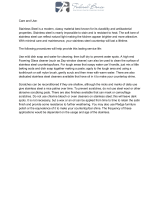
(5/13) 0000000793
USE AND CARE GUIDE
STAINLESS STEEL SINK
Easy Cleaning Instructions
Rinsing is the most important part of sink care. A stainless steel sink finish will retain its original
bright appearance if the sink is rinsed thoroughly after each use. Running the water from the
spray hose for a few minutes can do “Thorough” rinsing. Typically, a rinse and towel drying
after each use takes care of most everyday clean ups. Ideally, once a week the sink should be
scoured wit
h a mildly abrasive cleaner, such as Comet. Rubbing back and forth in the direction
of the polish or grain lines will not only remove stubborn stains and greasy film buildups, but will
blend usage scratches into the satin finish of the sink. After scouring, rinse thoroughly and wipe
dry. Your sink will shine like new!
Scratching
Like most metals, your new stainless steel sink will scratch. The feature benefit of the unique
satin finish is the ease with which these scratc
hes blend into the uniform finish of the sink. This
is accomplished with a periodic scouring with a mildly abrasive kitchen cleanser, such as
Comet.
Rubber Mats
The resiliency of stainless steel makes it unnecessary to use rubber mats to protect you sink,
dishes and glassware. However, if you do use mats, please remove them after each use. If left
in the sink, the water trapped underneath could cause discoloration.
Discoloration, Rust and Possible Pitting
Wet sponges, clothes, cleaning pads and rubber mats left on the sink can lead to discoloration.
Steel wool pads should never be used to clean your sink. Steel Wool will leave small iron
particles in the grain lines that will rust and damage the sink. Continued usage in this manner
may eventually lead to the sink itself rusting and pitting.
Liquid Soap
Do not allow concentrated liquid detergent to dry on your sink. Most brands contain chemical
additives that will affect the origin
al high luster finish.
Chlorides
Today, chlorides are found in most all soaps, detergents, bleaches and cleansers. Chlorides
are not friendly to the stainless steel surface. They should not come in contact with the surface
of the sink for extended periods. When these chemicals are used in your sink, it should be
thoroughly rinsed. This is especially noticed when clothes are soaked in a diluted bleach
mixture. The mixture can attack the sink at the water line and cause rust
ing and pitting.
Knives Your sink is designed to serve as many things but not as a cutting board or chopping
block. This type of use will lead to deep scratches in the sink finish and will dull your knives.
Spotting The quality of your water can affect your sink’s appearance. In areas with hard water,
a brown surface stain can form on the sink giving the appearance of rust. This phenomena also
occurs in water with high iron content. Additionally, in areas with a
high concentration of
minerals, or with over-softened water, a white film may develop on the sink. To combat this
problem, we suggest that the sink be towel dried after use.
Foods Heavy salt concentration or foods containing high levels of salt should not be allowed
to dry onto the sink surface. Rinse your sink thoroughly after use.





